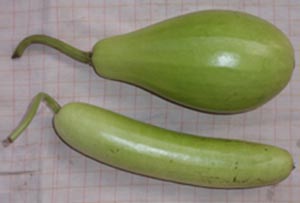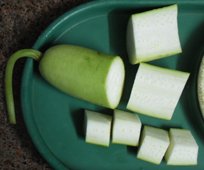Bottle gourd (Calabash) Nutrition facts
Bottle gourd or calabash is a delicately flavored, Cucurbita family vegetable. It is one of the chief culinary vegetables in many tropical and temperate regions around the world.
Botanically, calabash belongs to the broader Cucurbitaceae (gourd) family of plants, in the genus: Lagenaria. Scientific name: Lagenaria siceraria (Molina) Standl. Some of the common names are white-flower gourd, upo-squash (Filipino), long-squash, etc., in the west and doodhi or lauki in the Indian subcontinent.
 |
| Bottle gourd. Round and pear-shaped fruits are known as calabash in the West. |
Bottle gourd is a fast-growing, annual climber (vine) that requires adequate sunlight for flowering and fruiting. It can be grown in a wide range of soils and need trellis support for a spread.
Its intensely branched stems bear musky, deep green, broad leaves just similar as that in pumpkins, and white, monoecious flowers in the summer. After about 75 days from the plantation, young, tender, edible fruits evolve that will be ready for harvesting.
Bottle gourds come in a wide range of shapes and sizes. The fruit features oval, pear-shaped, or elongated and smooth skin that is light green. In the case of round or pear-shaped calabash, their surface is marked by inconspicuous ridges that run lengthwise. Internally, its flesh is white, spongy, and embedded with soft, tiny seeds. As the fruit begins to mature, its seeds gradually grow hard, similar to that in honeydew melons.
Health benefits of Bottle gourd
Bottle gourd is one of the lowest-calorie vegetables- carrying just 14 calories per 100 g. It is one of the vegetables recommended by dieticians in weight-control programs.
Fresh gourds contain small quantities of folates, containing about 6 µg/100g (Provide just 1.5% of RDA). Folate helps reduce the incidence of neural tube defects in newborns when taken by anticipant mothers during their early months of pregnancy.
Fresh calabash gourd is a modest source of vitamin C (100 g of raw fruit provides 10 mg or about 17% of RDA). Vitamin C is one of the powerful natural antioxidants that help scavenge harmful free radicals
Roughage (dietary fiber) in calabash facilitates easy digestion and movement of food through the bowel until it is excreted from the body. Thus, it helps in relieving indigestion and constipation problems.
Also, the vegetable is also a modest source of thiamin, niacin (vitamin B-3), pantothenic acid (vitamin B-5), pyridoxine (vitamin B-6), and minerals such as calcium, iron, zinc, potassium, manganese, and magnesium.
Its tender leaves and tendrils are also edible; indeed it carries higher concentrations of vitamins and minerals than the bottle gourd fruit.
| Principle | Nutrient Value | Percent of RDA |
|---|---|---|
| Energy | 14 Kcal | <1% |
| Carbohydrates | 3.39 g | 2.5% |
| Protein | 0.62 g | 1% |
| Total Fat | 0.02 g | 0.5% |
| Cholesterol | 0 mg | 0% |
| Dietary Fiber | 0.5 g | 1% |
| Vitamins | ||
| Folates | 6 µg | 1.5% |
| Niacin | 0.320 mg | 2% |
| Pantothenic acid | 0.152 mg | 3% |
| Pyridoxine | 0.040 mg | 3% |
| Riboflavin | 0.022 mg | 2% |
| Thiamin | 0.029 mg | 2.5% |
| Vitamin A | 16 IU | 0.5% |
| Vitamin C | 10.1 mg | 17% |
| Electrolytes | ||
| Sodium | 2 mg | <1% |
| Potassium | 150 mg | 3% |
| Minerals | ||
| Calcium | 26 mg | 2.6% |
| Copper | 0.034 mg | 4% |
| Iron | 0.20 mg | 2.5% |
| Magnesium | 11 mg | 3% |
| Manganese | 0.089 mg | 4% |
| Phosphorus | 13 mg | 2% |
| Selenium | 0.2 mg | <1% |
| Zinc | 0.70 mg | 6.5% |
Selection and storage
Bottle gourds can be available around the season in the regions wherever suitable conditions for their growth exist. In the markets, look for fresh produce featuring tender, medium-sized, uniform, light green color fruit. Take a close look at its stem, which may offer a valuable hint of whether the produce is fresh or aged.
Avoid those with oversized, mature, yellow discoloration, cuts, and bruises on their surface. Tiny spots on the surface, however, would not lessen their quality.
At home, store them in the refrigerator set at adequate humidity where they stay fresh for 3-4 days.
Preparation and serving methods

|
| Bottle gourd cut sections. Note for ice-white, spongy flesh, and tiny, soft seeds. |
Bottle gourd is one of the most common vegetables in continuous use since ancient times. To prepare, wash the fruit in cold water and dry mop using a soft cloth or paper towel. Trim its top end in case of a round or pear-shaped calabash and either end in case of an elongated gourd. Peeling may not be required in the case of tender fruits. Chop the fruit into uniform chunks for even cooking.
Here are some serving tips:
Fresh calabash is used in a variety of stews, curries, and sweet recipes across the world. In the Indian subcontinent where it is popularly known as lauuki, employed in the preparation of sabzi, sambar, chutney, soup, raita, etc.
In India and Pakistan, its flesh is used to prepare a mouth-watering sweet dish, lauki-ki-halwa.
In Africa, where it is thought to have taken its origin, calabash is used in stews with meat, poultry, and seafood.
Ginisang-upo (sauteed bottle gourd) is a popular stir-fried dish among the Filipinos.
In India, bottle gourd juice is consumed for its little-known health benefits in traditional medicine.
The gourd is known as yugao in Japanese, where its white flesh shaved into thin strips 3 cm wide and 3 mm thick, then either dried in the sun or dehydrated to prepare Kanpyō (かんぴょう or 干瓢). Kanpyō strips used in sushi rolls in place of nori.
Safety profile
Under environmental adversities, some of bottle gourds may develop cucurbitacins, a naturally occurring toxin, in excessive amounts. These terpenoid toxic compounds such as cucurbitacin B, D, G, H, etc, tend to accumulate in them.
Bottle gourd poisoning occurs when a bitter fruit is consumed either raw or juiced. Incidents of serious illness and death have been reported in India after drinking bitter bottle-gourd juice for its purported health benefits. Symptoms may include vomiting, stomachache, and diarrhea and can occur within minutes of ingestion of toxic juice which may follow serious illnesses like bleeding from the gut, shock, and death.
ICMR (Indian Council of Medical Research) recommends the following guidelines regarding bottle gourd consumption to the public:
1. Taste a small piece of bottle gourd before extracting the whole fruit juice to ensure that it is not bitter. If found so, then discard the whole fruit.
2. Bitter bottle gourd juice should not be consumed at all.
3. Do not mix bottle gourd juice with any other juice.
4. In case of discomfort after consumption (nausea, vomiting, diarrhea, or any feeling of uneasiness), the person should be immediately taken to a nearby hospital. (Medical disclaimer).
Also read ≻≻
≺≺ Ash gourd (Chinese winter melon) nutrition facts.
≺≺ Snake gourd (Chichinda) nutrition facts.
≺≺ Bitter gourd (bitter melon) nutrition facts.
≺≺ Ivy gourd (kundru) nutrition facts.
≺≺ Pointed gourd (parwal) nutrition facts.
≺≺ Ridge gourd (Luffa) nutrition facts.
≺≺ Back to Vegetables from Bottle gourd nutrition. Visit here for an impressive list of vegetables with complete illustrations of their nutrition facts and health benefits.
≺≺ Back to Home page.
Further reading: